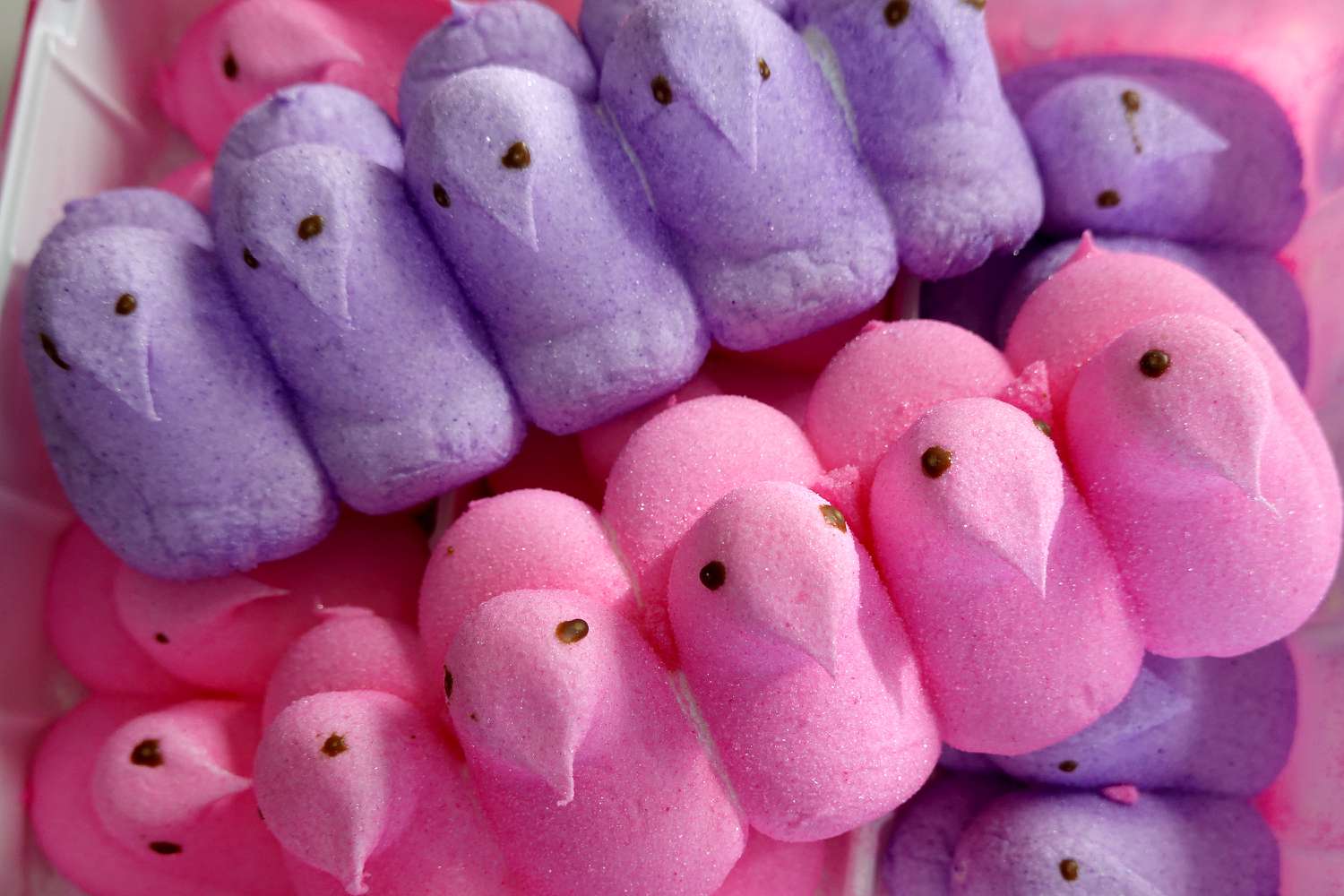Peeps ripoti sostengono che siano fatti con un ingrediente "cancerogeno" - dovresti preoccuparti del Red Dye 3?

I dolciumi Peeps sono un punto fermo per molte persone durante la Pasqua e le celebrazioni della primavera. Ma la tintura usata per dare il colore ad alcuni Peeps, ovvero la tintura rossa n. 3, ha preoccupato alcuni sostenitori dei consumatori, i quali ritengono che tale tintura possa fare più male che bene.
Una nota stampa di Consumer Reports, pubblicata lunedì, ha avvertito i consumatori che i pulcini e i conigli di marshmallow Peeps lavanda e rosa, nonché alcuni altri prodotti di caramelle Just Born Quality Confections, contengono la tintura rossa n. 3. Il gruppo di difesa dei consumatori ha definito tale tintura un "carcinogeno noto".
Consumer Reports, il Center for Science in the Public Interest e molti altri gruppi di difesa hanno presentato lo scorso autunno una petizione alla Food and Drug Administration (FDA) per chiedere che la tintura rossa n. 3 venga vietata nei cibi e nei supplementi alimentari. Tale petizione è attualmente in fase di revisione.
Inoltre, insieme a questa petizione, i legislatori della California stanno ora valutando la possibilità di vietare la tintura rossa n. 3 e altre sostanze nei cibi, come il biossido di titanio. Tali sostanze sono tutte vietate nell'Unione Europea e la legge riprogetterebbe gli stessi obiettivi di protezione dei consumatori in California.
Tuttavia, non esiste ancora evidenza sufficiente che la tintura rossa n. 3 abbia gli stessi effetti negativi sulla salute delle persone o sia la causa di problemi comportamentali, rispettivamente. E la FDA, per ora, continua a considerare sicure le sostanze coloranti come la tintura rossa n. 3.
"Negli studi sugli animali si è riscontrata una certa preoccupazione per il cancro. Tuttavia, questo non si traduce in ciò che potrebbe accadere negli esseri umani. E non c'è informazione sulla quantità necessaria perché ciò accada", ha dichiarato a Health Shelly Wegman, RD, dietista per i servizi nutrizionali ambulatoriali presso l'Università di North Carolina Rex Healthcare. "Sicuramente, sono necessarie ulteriori ricerche".
La tintura rossa n. 3 è in realtà una tintura rosa, ha spiegato Wegman, che può essere chiamata con vari nomi, tra cui eritrosina e il termine FD&C Red #3 della FDA. La tintura è sintetica e deriva dal petrolio o dal carbone.
Secondo Wegman, la tintura rossa n. 3 è una delle tinture alimentari sintetiche meno utilizzate - le persone potrebbero essere molto più familiari con la tintura rossa n. 40, tra le più comuni.
Nonostante ciò, ci sono circa 2.900 prodotti che contengono la tintura rossa n. 3, secondo l'Environmental Working Group. Oltre ai Peeps lavanda e rosa, sono compresi nell'elenco alcune marche di caramelle di mais, jelly beans e altre caramelle, nonché glassa, frutta altamente lavorata e altro.
Tuttavia, la tintura rossa n. 3 non è una sostanza chimica nuova. La mancanza di consenso sulla sua sicurezza potrebbe risalire a tre decenni fa.
La tintura è stata vietata dalla FDA nel 1990 in risposta a uno studio del 1988 che ha riscontrato che la tintura rossa n. 3 causava tumori alla tiroide nei ratti. Il divieto, ancora oggi in vigore, si applica solo all'uso della tintura rossa n. 3 nei cosmetici, nei farmaci applicati esternamente e in alcune forme di pigmento.
All'epoca, l'agenzia ha ribadito che il rischio di contrarre il cancro dalla tintura rossa n. 3 era di circa 1 su 100.000, come riportato dal New York Times. La FDA ha anche detto al giornale che "è in corso l'estensione del divieto per coprire" anche i cibi e i farmaci. Tuttavia, ciò non è accaduto, il che è stato un punto di discussione per i sostenitori speranzosi di vietare la tintura rossa n. 3.
"La tintura rossa n. 3 è stata vietata dalla FDA dall'uso nei cosmetici dal 1990, ma inspiegabilmente è ancora consentita nei cibi", ha dichiarato Michael Hansen, PhD, scienziato capo di Consumer Reports, in una nota stampa. "È ora che la FDA protegga la salute pubblica eliminando la tintura rossa n. 3 dai nostri alimenti".
Tale discrepanza tra cosmetici e cibi potrebbe dipendere dal fatto che non ci sono state prove concrete sufficienti per estendere il divieto, ha spiegato Wegman.
Lo studio sui ratti che ha fatto scattare il divieto dei cosmetici nel 1990 non significa necessariamente che la tintura rossa n. 3 sia un cancerogeno per gli esseri umani, ha aggiunto Wegman. Non è neanche chiaro se esiste una quantità specifica che gli esseri umani dovrebbero consumare per rischiare gli stessi problemi di cancro ed è possibile che la tintura rossa n. 3 non sia assorbita dal corpo umano allo stesso modo in cui lo era nel corpo dei ratti.
Una recente revisione di studi ha riscontrato che i dati "supportano una relazione tra l'esposizione alle tinture alimentari e gli effetti comportamentali negativi nei bambini, sia con che senza disordini comportamentali preesistenti". Wegman ha dichiarato che sono necessari ulteriori studi per approfondire un po' di più questa connessione.
“The biggest potential is there might be some people who are sensitive to [red dye No. 3],” she said. “There are people who are sensitive to several different compounds found in food—synthetic or naturally-occurring. So it’s one of those [where] you may need to be cautious.”
In the face of concerns about red dye No. 3’s safety, there are a number of advocates on the opposite side of the aisle who believe that misgivings about the dye are unfounded.
“Colors are safely used in a wide variety of consumer products, are among the most widely studied food ingredients, and are subject to strict global regulatory requirements,” Sarah Codrea, executive director of International Association of Color Manufacturers, told Health in a statement. The IACM organization promotes the interests of the color additives industry.
“The FDA and international regulatory bodies have all concluded that FDA-certified colors, including FD&C Red No. 3, are safe for children,” Codrea said.
Some, like California Assemblymember Jesse Gabriel, who’s sponsoring the bill to ban red dye No. 3, seem to fall into the camp that the potential risks outweigh any benefits of chemical dyes, especially when there are alternatives.
“The idea here is for these companies to make minor modifications to their recipes so that these products don’t include dangerous and toxic chemicals,” he told Health in a statement. “Skittles and many other brands have already made changes to their recipes in the EU, the UK, and other nations where these chemicals are banned. We simply want them to do the same thing in the US.”
It’s also true that many of the products that have red dye No. 3 are linked to poorer health outcomes because they contain high amounts of added sugar.
“When you’re eating foods that possibly contain the red dye 3, they are going to be either candy or highly-processed foods to begin with,” Wegman said. “So if you can reduce your intake of highly-processed foods, that’s always a positive for health.”
While the FDA reviews the petition to ban red dye No. 3 and evidence into whether the product should be considered harmful to the public, there are things people can do to cut the dye out of their diets of their own accord, especially if they’re worried about its effect on their children.
“The FDA requires all color additives to be listed on product labels so that they can be identified by consumers,” an FDA spokesperson told Health. “Consumers who wish to limit the amount of color additives in their diets may check the food ingredient list on labels.'
It’s worth noting that not all consumers may not be able to cut out red dye No. 3, especially if they rely on these more highly-processed foods due to cost, access, or other reasons.
But as is the case with most things, Wegman said that moderation may be a good strategy.
“People can have treats. It’s just how much do you eat at one time and how often?” Wegman said. “A daily consumption of an Easter basket full of candy, versus having a few pieces here and there, is very different on how all of the ingredients are going to affect your body.”




